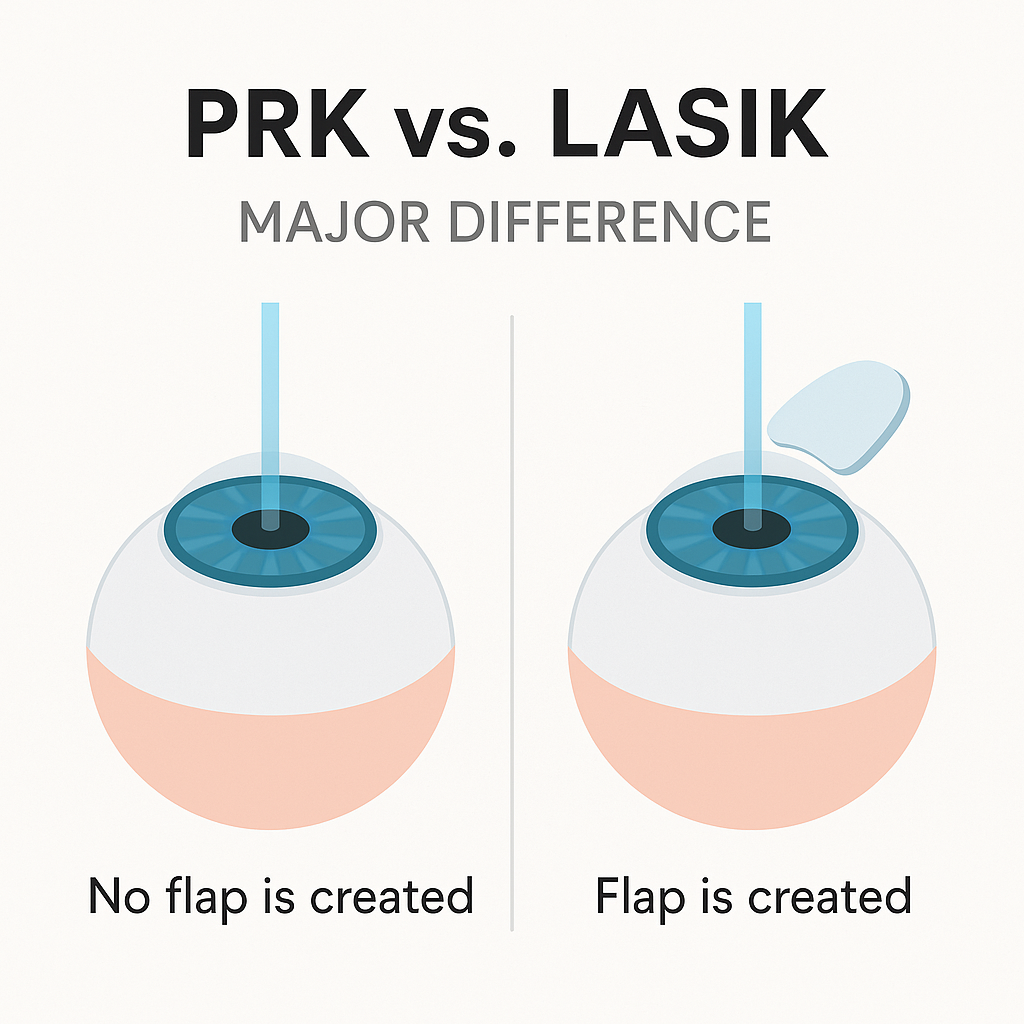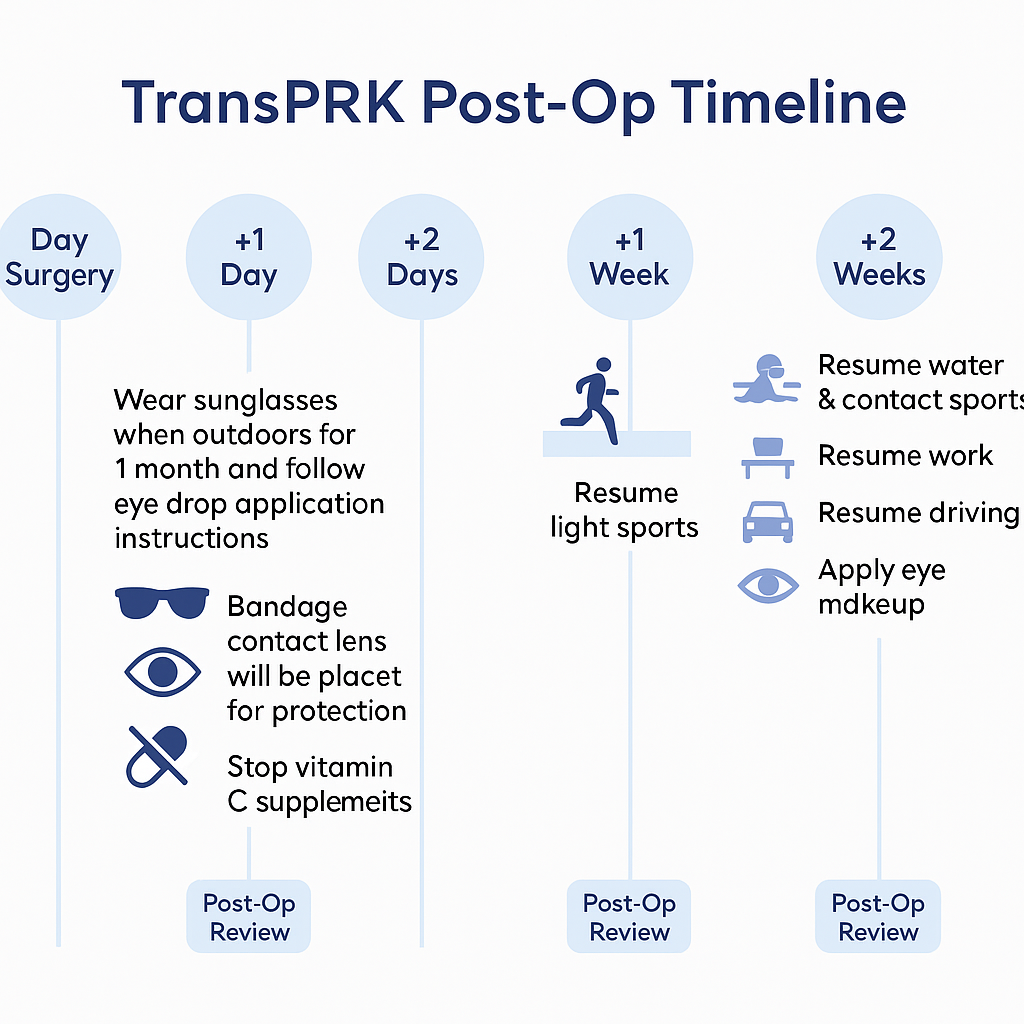Trans PRK laser eye surgery has transformed vision correction. More than 95% of patients now see better without glasses. This advanced technique uses an excimer laser to remove corneal tissue with incredible precision. The best part is that nothing touches the eye during the procedure. This no-touch approach is really important because it makes the cornea more stable and cuts down the risk of infections and swelling.
You might wonder what PRK laser eye surgery actually is. The procedure has come a long way since 1987, and Trans-PRK is now its most advanced version. On top of that, it works great for certain patients, especially when you have thin, irregular, or problematic corneas that aren’t right for LASIK. The recovery time takes about a week, while LASIK patients are back on their feet in a day or two. But many doctors still prefer this method because there’s no flap to worry about – then there’s no risk of flap problems either. Athletes, military personnel, and anyone who might get eye injuries love this flap-free approach because it gives them peace of mind and results that last.
What Makes Trans-PRK a No-Touch Procedure

Image Source: SCHWIND eye-tech solutions
Trans-PRK laser eye surgery stands out from regular eye procedures because it never touches the eye. The procedure treats the cornea without any surgical instruments making contact with the eye’s surface.
Excimer Laser Use in Epithelial Removal
The life-blood of PRK laser eye surgery uses an excimer laser to remove the corneal epithelium (the outermost layer). The process starts with anesthetic drops to numb the eye. The ultra-precise excimer laser at 193 nm wavelength removes this epithelial layer to a depth of approximately 50 μm . This creates a more even ablation compared to traditional PRK methods that scrape off the epithelium mechanically or use alcohol .
No Flap, No Blade: How It Is Different from LASIK
The main difference between Trans-PRK and LASIK is that Trans-PRK doesn’t create a flap. LASIK creates a thin corneal flap using either a microkeratome blade or femtosecond laser before reshaping the cornea underneath. Trans-PRK needs no cuts at all . This flap-free approach removes risks like displacement, wrinkling, or infection . More importantly, patients with thin corneas who can’t get LASIK can often qualify for Trans-PRK .
Single-Step Laser Application with SCHWIND AMARIS
SCHWIND AMARIS excimer laser system represents the latest technology in Trans-PRK procedures. This advanced system combines epithelium removal and corneal reshaping into one continuous process . The system first removes the epithelium and then fixes the refractive error right away . The laser works at high speeds of 500/750/1050 Hz with precise control . The SmartPulse technology arranges laser pulses perfectly, which leads to smoother tissue removal and quicker healing . The Intelligent Thermal Effect Control (ITEC) software keeps local frequency at 39 Hz, so corneal tissue stays below 40°C where protein damage begins .
This is a big deal as it means that eye surgeons worldwide have performed over 825,000 treatments using the SCHWIND AMARIS system .
Benefits of Trans-PRK Over Traditional PRK and LASIK

The advantages of Trans-PRK compared to traditional vision correction approaches make a substantial difference. Eye specialists prefer this method for many patients because it offers several unique benefits.
Reduced Risk of Flap Complications
Trans-PRK’s biggest advantage over LASIK comes from eliminating flap-related issues completely. The “no flap = no flap complications” principle is the life-blood of this procedure . LASIK patients face a lifelong risk of corneal flap displacement , among other complications like wrinkling or infection. Trans-PRK uses innovative technology without creating incisions, which avoids these concerns .
Faster Epithelial Regeneration
Traditional PRK methods might show quicker original epithelial healing rates . However, Trans-PRK provides better regeneration quality. Modern Trans-PRK platforms use a single-step process that creates a smaller, healthier epithelial edge. This leads to:
- Less patient discomfort
- Much fewer subclinical recurrent epithelial erosions (1% in Trans-PRK vs. 12% in alcohol-assisted PRK)
- Less morning pain (1.4% Trans-PRK vs. 15.7% traditional PRK)
Lower Risk of Infection and Inflammation
Trans-PRK helps epithelial cells regenerate faster. The no-touch approach reduces infectious keratitis risk during recovery . Regular PRK has a keratitis risk between 0.01% and 0.8% . Trans-PRK’s minimal invasive approach lowers this risk even further. The procedure treats every area of Bowman membrane, which protects against epithelial erosions .
Ideal for Thin or Irregular Corneas
Trans-PRK brings hope to patients who couldn’t get LASIK. The procedure works great for:
- Thin corneas because it doesn’t sacrifice sub-Bowman stroma for flap creation
- Irregular corneas, including post-keratoplasty eyes and retreatment cases
- Cases where corneal instability rules out flap procedures
Trans-PRK preserves between 25-75 μm of corneal tissue . This is a big deal as it means that larger optical zones (exceeding 7.8 mm) can be used for low myopia, which results in better visual quality .
Also Read: Why Harley Street Remains London’s Most Trusted Laser Eye Surgery Hub
Who Is a Good Candidate for Trans-PRK?

Trans PRK laser eye surgery stands out as an excellent vision correction choice. Several key factors help determine if you’re the right candidate for this no-touch procedure. Let’s look at which patients benefit most from this advanced treatment.
Patients with Thin Corneas or Dry Eyes
People whose corneal thickness measures below 500 μm often find Trans PRK their best option because LASIK might not work for them. Studies have shown PRK procedures are safe and effective for patients with corneas thinner than what LASIK requires. The procedure preserves more corneal tissue since it doesn’t need a flap creation, making it ideal for naturally thin corneas.
On top of that, patients with dry eyes usually do better with Trans PRK. The procedure keeps more corneal nerves intact compared to LASIK, which leads to fewer dry eye issues after surgery.
Athletes and Military Personnel
Military personnel, police officers, and contact sport participants make perfect candidates for PRK laser eye surgery. No corneal flap means zero risk of flap displacement during physical activities or potential trauma. This added security proves especially valuable for boxers, wrestlers, martial arts practitioners, and other athletes who participate in high-impact sports.
Age and Prescription Stability Requirements
Candidates should be at least 18 years old to undergo Trans PRK. Your prescription needs to stay stable with less than 0.5 diopters change for 6-12 months before surgery. The good news is that there’s no upper age limit for Trans PRK candidates as long as the eye surface remains healthy.
Contraindications: Keratoconus, Glaucoma, Pregnancy
These conditions might rule out Trans PRK laser surgery as an option:
- Corneal disorders: Keratoconus, corneal edema, or corneal dystrophies
- Eye conditions: Uncontrolled glaucoma, cataracts affecting vision, or active ocular inflammation
- Systemic factors: Autoimmune diseases (rheumatoid arthritis), poorly controlled diabetes
- Hormonal changes: Pregnancy and breastfeeding (due to refractive instability)
Trans PRK works best for specific vision ranges. These include myopia up to -6 diopters, hyperopia up to +3 diopters, and astigmatism up to -5 diopters. Cases beyond these ranges might need different treatment options.
Trans-PRK Recovery Timeline and Aftercare

The recovery process after Trans PRK laser eye surgery follows a predictable pattern. Each patient’s healing experience can be different. A clear understanding of post-surgery expectations helps patients prepare both mentally and physically.
Day-by-Day Healing Expectations
Doctors place a high-oxygen bandage contact lens over the treated eye right after Trans PRK. This protects the cornea and makes epithelial healing easier . The first 24-48 hours need complete rest with minimal screen time and reading . Patients experience foreign body sensation, burning, stinging, and watering during days 1-2 . The epithelium typically grows back by days 3-5, though vision stays hazy . The bandage contact lens comes off around day 5 if the epithelium heals properly . Vision improves to about 80% after one week .
Pain Management in First 48 Hours
Pain reaches its peak between 1-3 days after surgery . Most patients rate their pain as severe (≥7/10) at some point . Doctors usually prescribe these treatments to work:
- Oral pain medications like ibuprofen or prescribed analgesics
- Cold compresses on closed eyelids every 30 minutes while awake (this reduced pain from 3.25 to 2.16 on a 10-point scale)
- Topical NSAIDs combined with corticosteroids for the first two days
Ketorolac-soaked bandage contact lenses showed remarkable pain reduction compared to standard lenses (2.76 vs 7.95 on a 10-point scale) .
Vision Clarity Progression Over 2 Weeks
Vision follows a unique pattern after Trans PRK. It starts somewhat clear right after surgery, then gets increasingly blurry during healing . Vision starts improving once the epithelium grows back during days 3-5 . Most patients can handle routine activities within one week, though vision might fluctuate . Reading fine print or extended near work could be challenging . Vision becomes notably clearer after two weeks . All the same, visual fluctuations might last 2-3 months until complete stabilisation .
Follow-Up Schedule and Medication Use
Regular follow-up appointments happen on day 1, day 5 (contact lens removal), 1 week, 2 weeks, 1 month, 2 months, and 3-6 months after surgery . The bandage contact lens comes off and antibiotic drops stop at the 5-day appointment if the epithelium has healed . Corticosteroid drops continue for about one month . Lubricating drops help you manage dryness as needed . UV-protective sunglasses become essential outdoors for at least one month during recovery .
Conclusion
Trans-PRK Laser eye surgery has revolutionised vision correction technology. The recovery takes a bit longer than LASIK, but patients find the benefits far outweigh this short-term inconvenience. The no-touch approach eliminates complications related to flaps and preserves more corneal tissue. This gives patients with thin or irregular corneas a substantial advantage.
Athletes and military personnel get unique benefits from this procedure. Their active lifestyle works better without a corneal flap that might shift during physical activity. The procedure also has lower risks of infection and inflammation, which makes it a great choice if you have concerns about complications after surgery.
Your vision will improve to about 80% clarity within a week of recovery. Most patients see substantially better after two weeks. Full stabilisation usually takes 2-3 months. Your results will be best when you follow your doctor’s guidance about medications and checkups.
Experience next-level vision correction with Trans-PRK at Precision Vision London – a safe, no-touch laser eye surgery. Book your consultation today! This procedure definitely offers lasting vision improvement without traditional method’s drawbacks. The technology behind Trans-PRK keeps getting better, which makes this impressive procedure even more effective to help patients live freely without glasses or contacts.
FAQs
Q1. What are the main advantages of Trans-PRK over traditional laser eye surgeries? Trans-PRK offers several benefits, including reduced risk of flap complications, faster epithelial regeneration, lower risk of infection and inflammation, and suitability for patients with thin or irregular corneas. It’s also an ideal option for athletes and military personnel due to its no-flap approach.
Q2. How long does recovery take after Trans-PRK surgery? Recovery after Trans-PRK typically takes about a week, with vision improving to approximately 80% clarity within this time. Most patients experience significantly better vision after two weeks, although complete stabilization may take 2-3 months.
Q3. Are there any restrictions on activities following Trans-PRK? For the first 1-2 weeks after surgery, it’s advisable to avoid swimming, hot tubs, gardening, and dusting. Patients should also limit screen time, especially in the first 24 hours, and wear sunglasses on bright days for at least a year post-surgery.
Q4. Who is an ideal candidate for Trans-PRK? Ideal candidates for Trans-PRK include individuals with thin corneas or dry eyes, athletes, military personnel, and those over 18 with stable vision prescriptions. However, it’s not recommended for people with certain eye conditions like keratoconus, uncontrolled glaucoma, or during pregnancy.
Q5. What should patients expect during the immediate recovery period after Trans-PRK? In the first 48 hours after surgery, patients may experience discomfort, including a foreign body sensation, burning, and watering eyes. Vision may be hazy for the first 3-5 days. Pain management typically involves oral medications, cold compresses, and special eye drops prescribed by the doctor.
Authors & Reviewer
-
 Olivia: Author
Olivia: AuthorHi, I'm Olivia, a passionate writer specialising in eye care, vision health, and the latest advancements in optometry. I strive to craft informative and engaging articles that help readers make informed decisions about their eye health. With a keen eye for detail and a commitment to delivering accurate, research-backed content, I aim to educate and inspire through every piece I write.
-
 Dr. CT Pillai: Reviewer
Dr. CT Pillai: ReviewerDr. CT Pillai is a globally recognised ophthalmologist with over 30 years of experience, specialising in refractive surgery and general ophthalmology. Renowned for performing over 50,000 successful laser procedures.

